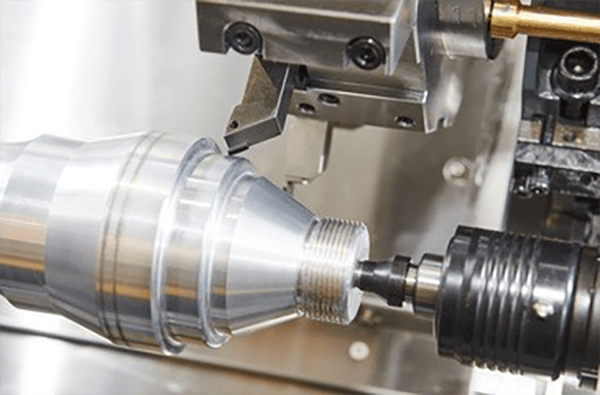
Obtaining designated surface condition on a machined article is critical.
- CAD annotations convey exact surface criteria for production
- Surface notes typically employ Ra—arithmetic mean deviation—when specifying roughness
- Knowing how to read finish callouts is critical for meeting performance goals
- Designated finish alters fluid film formation, friction levels, and durability outcomes
- Precise decoding of callouts secures the specified finishing outcome
Precision Principles of CNC Machining

Robotic-assisted machining defines a modern manufacturing practice using computerized programs to drive machines that cut complex shapes with high precision.
- This process enables the creation of high-quality parts from a wide range of materials
- CNC adaptability suits industries including aerospace and automotive sectors
- CNC machining delivers exceptional repeatability ensuring identical parts across production runs
From initial prototype stages to mass-manufacture CNC machining supports modern production workflows
Reading CNC Machine Specs
Navigating specification tables often appears formidable at first sight
Still a modest foundation of know-how combined with structure allows navigating specs
Kick off by isolating primary specs such as rpm, feed, tolerance, workspace, controller
All these parameters affect the tool’s total functional output.
By way of example raised spindle rpm benefits soft stocks while boosted feed enhances output.
Understanding these relationships will allow you to select the right CNC machine to match your specific requirements
It’s wise to study manufacturer documentation comprehensively.
Vendor literature commonly contains useful guidance and explains terms
CNC Machinery: An Exhaustive Guide
Computer numerical control machines denote software-driven tools for precise automated fabrication of many substances They accept digital G-code to steer tools and control machining actions.
- Frequent CNC varieties include mills, lathes, routers, plasma cutting machines
- CNC machining processes are highly versatile and can be used to work with a wide range of materials including metals plastics wood and composites
- Additionally CNC gear supports fast prototyping and limited production for entrepreneurs and institutes
Fundamental CNC Machine Concepts
They exemplify the union of precise mechanics and modern control software Flexible equipment harnesses software instructions to automatically fabricate basic components and intricate assemblies The core idea is converting digital blueprints into tangible parts.
- Programmed machining process
- Programmed manufacturing process
It includes exact tool motions driven by CNC instructions Machine operators handle parameter selection, process monitoring, and quality confirmation.
The Role of Surface Finish in CNC Machining
Meeting set surface quality in CNC work is significant It changes how a part performs and how it looks Workpiece material, tool settings, and secondary finishing processes determine texture.
Fine finishes raise resilience whereas rough profiles can restrict performance CNC machining processes offer a wide range of tools and techniques to achieve the specific surface finish for different applications.
- Such as employing varied cutter geometries |coated inserts|tool speed tuning to deliver finish
- Moreover post-machining steps like polishing or sanding improve surface quality
Knowing parameter-to-finish links is vital to secure the best results.
CNC Machine Basics: From Operation to Applications
Computerized machining precisely produces parts from metals, plastics, and other materials These machines follow digital instructions to execute intricate designs with high accuracy and repeatability Comprehending toolpaths, G-code, and tooling strategies supports effective machining
Applications of CNC machining are incredibly diverse spanning numerous industries such as aerospace automotive manufacturing From fine aerospace pieces to intricate mold geometries, CNC underpins complex manufacturing
Specifying Surface Roughness for CNC Parts
Proper specification of surface finish is crucial when machining parts on a CNC machine It ensures part compliance with operational and appearance standards Manufacturers often rely on Ra (roughness average) to represent surface finish The value, shown in µm or inches, quantifies mean surface irregularity height.
Consider needed smoothness and the part’s application to determine finish requirements

Often a polished surface is selected when precise tolerance and fit are required
Coarse finishes can benefit components where traction or friction are functional
Employ an unambiguous finish note on drawings to specify surface expectations Enter the Ra specification and describe any post-process finishing or treatments.
Understand that effective surface annotations are critical to production success
CNC Machine Categories and Capabilities
Numerical control machining comprises numerous machine types engineered for diverse applications They leverage CAD/CAM designs to instruct cutters for accurate and efficient fabrication.
- Boring and drilling equipment generate accurate holes and internal features
- Grinders use abrasive wheels to finish and size parts to fine tolerances
- Waterjet tools cut ceramics composites and metals with no heat-affected zone
Equipment choice hinges on material, design intricacy, and precision requirements Unique machine capabilities support varied industry needs such as automotive, aerospace, and medical.
Obtaining High-Quality Surface Finish with CNC
Attaining top-quality surfaces is critical in fabrication and CNC techniques facilitate that achievement Through careful tuning of feeds speeds and tool profiles operators manage chip formation and surface generation Furthermore the utilization of high-quality tooling materials and proper lubrication techniques contributes to a smoother finish Through careful selection of cutting strategies and meticulous machine setup CNC machining enables the creation of components with exceptional surface quality for diverse applications.
Obtaining Surface Quality via CNC Code
Programming mastery of surface parameters is essential for desired outcomes Cutting parameter selection—feed, speed, tool geometry—controls surface finish Meticulous parameter tuning together with suitable coolant use promotes smoother finishes.
- Moreover scheduled tool maintenance and inspection preserve surface performance Furthermore regular tool maintenance and inspection are essential for ensuring a consistent and high-quality surface finish over time Besides that systematic tool upkeep and monitoring ensure sustained surface quality
- For better finishes evaluate substrate, roughness goal, and functional context
- CAM previews let programmers modify strategies to avoid finish defects
- Additionally routine tool checks and upkeep maintain consistent finish quality
